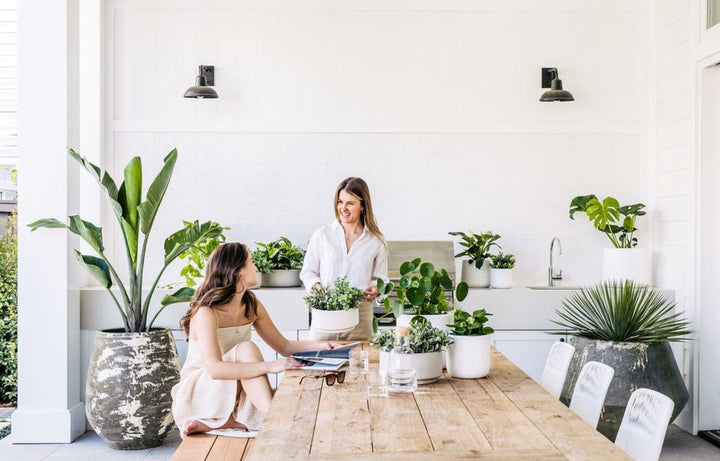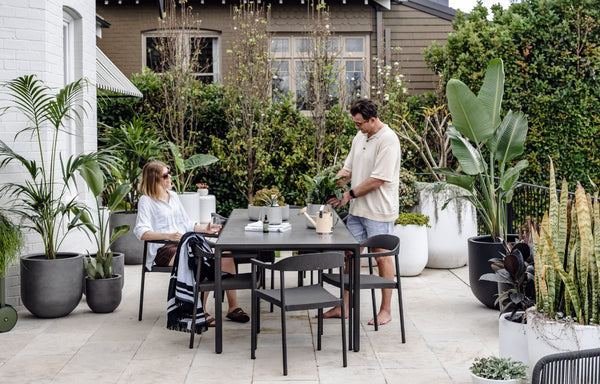
Bringing Your Indoor Plants into the Outdoor World
Bringing Your Indoor Plants into the Outdoor World
Many of our favourite indoor plants are tolerant of temperate outdoor conditions and often do just as well when grown on balconies and patios as they do indoors. Occasionally moving your indoor plants outside can provide numerous benefits for your plants, not to mention providing a refreshing change of scenery that can invigorate their overall health.

What are the benefits of moving indoor plants outdoors?
Increased sunlight exposure:
- Natural sunlight outdoors is richer in intensity and spectrum compared to artificial indoor lighting.
- Sunlight is essential for photosynthesis, promoting healthier growth and vibrant foliage.
- Increased light exposure leads to the production of vital nutrients, supporting overall plant vigour.
- Indoor plants often suffer from stagnant air, but moving them outdoors allows for better air circulation, which helps prevent diseases and pests.
- Plants contribute to outdoor air purification by absorbing pollutants and releasing oxygen.
- Exposure to natural air encourages plants to thrive and improves indoor air quality upon return.
Seasonal Adaptation:
- Moving plants outdoors exposes them to natural temperature and humidity variations.
- This exposure readies plants for seasonal changes and prepares them for indoor conditions during colder months.
- Seasonal transitions encourage dormancy in certain plant species, promoting longevity.
- The wider range of temperatures, humidity levels, and natural elements found outdoors can stimulate plant growth.
- Plants that have a temperature, humidity or seasonal growing preference often produce healthier growth when exposed to outdoor conditions that simulate their natural habitat.
- The exposure to natural stimuli can also trigger dormant plants to bloom and thrive.
Increased space:
- Indoor plants may become cramped over time, but placing them outdoors provides more space for their leaves to spread out and unfurl unimpeded.
- It also allows the undergrowth to receive more airflow and sunlight exposure that is usually covered by larger foliage.
Improved aesthetic appeal:
- Outdoor plants can add beauty and vibrancy to your garden or patio, enhancing the overall visual appeal of your outdoor space.
- Caring for plants outdoors is not only good for our green friends but offers a refreshing change of scenery with many health benefits for us too.
What are the negatives of moving indoor plants outdoors?
While there are benefits to moving indoor plants outdoors, it's important to consider the potential negatives when not carefully monitored.
- Temperature extremes: Outdoor plants are exposed to fluctuating temperatures, which can be detrimental to certain indoor plants that prefer stable conditions.
- Pest infestation: Outdoor environments may harbour pests and insects that can attack and damage your indoor plants.
- Weather conditions: Harsh weather conditions such as heavy rain, strong winds, or extreme heat can negatively impact the health of your indoor plants.
- Overexposure to sunlight: Constant, direct sunlight can lead to leaf burn, stunted growth, dehydration, and root stress for some indoor plants.
- Plant shock: Sudden hot or cold changes in the environment can cause stress and shock to moderate climate-loving indoor plants, leading to wilting or even death.
- Loss of control: When plants are moved outdoors, you have less control over their growing conditions, making it harder to maintain their health and well-being.

Which plants benefit from being outdoors?
While not all indoor plants thrive outdoors, some species can greatly benefit from the transition. Here are a few examples:
- Indoor favourites: Including but in no way limited to large leafy plants like Monsteras, Philodendrons, and Bird of Paradise. Fiddle Leaf Figs also benefit, but it first needs to be acclimatised to the outdoor conditions.
- Succulents: Succulents, such as Aloe Vera and Echeveria, thrive in outdoor environments due to increased sunlight and better drainage.
- Herbs: Culinary herbs like basil, rosemary, and thyme flourish when grown outdoors, as they require ample sunlight and good air circulation.
- Flowering plants: Many flowering plants, including Jade Plants and Begonias, produce more vibrant blooms when exposed to natural outdoor conditions.
- Fruit trees: Fruit trees like Olive and Citrus Trees require the space and sunlight provided by outdoor environments to bear fruit.
Which plants should not be moved outdoors?
While some plants thrive outdoors, others are better off staying indoors. Here are a few examples of plants that should not be moved outdoors:
- Tropical plants: Plants like Orchids, Ferns, and Peace Lilies prefer the warm and humid conditions found indoors, making them unsuitable cooler outdoor environments.
- Sensitive plants: Some plants, such as African Violets and Maidenhair Ferns, are sensitive to temperature fluctuations and should be kept in a controlled indoor environment.
- Indoor succulents: While certain succulents thrive outdoors, many indoor succulents, like Haworthia and Gasteria, prefer the lower light levels and controlled conditions indoors.
- Houseplants with pests or diseases: If your indoor plants are already struggling with pests or diseases, it's best not to move them outdoors to prevent spreading the issues to other plants.
Remember, before moving any indoor plant outdoors, it's important to research its specific care requirements and consider the climate and conditions of your outdoor space. By understanding the benefits and negatives, you can make informed decisions to ensure the health and well-being of your plants.
You might also enjoying reading about Bamboo - Nature's Super Plant
